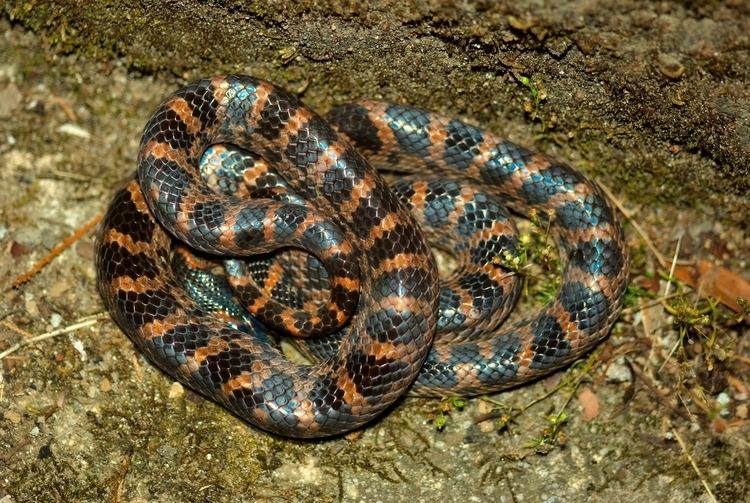Kingdom Animalia Family Colubridae Scientific name Dinodon rufozonatum Higher classification Dinodon Order Scaled reptiles | Suborder Serpentes Genus Dinodon Phylum Chordata Rank Species | |
 | ||
Similar Chinese water snake, Asiatic toad, Small‑webbed Bell Toad, Rice paddy snake, Tibetan toad | ||
Dinodon rufozonatum is a species of nocturnal snake in the family Colubridae, native to East Asia. It is typically 70 cm (28 in) long, and is considered non-venomous. Two subspecies are recognised, one of which is restricted to the Ryukyu Archipelago.
Contents
Description
Dinodon rufozonatum typically grows to a length of around 70 centimetres (28 in), reaching up to 130 cm (51 in) in extreme cases. The head is long and relatively flat, and somewhat separate from the neck. The medium-sized eyes bulge slightly and have vertical pupils. The ventral scales have a strong keel, while the dorsal scales are only faintly keeled; the scale count is typically 17:17:15, but can be up to 21:19:17.
Distribution
Dinodon rufozonatum is found across a large part of East Asia, from the Korean Peninsula in the north (and extending just into easternmost Russia) to northern Laos and Vietnam in the south; the bulk of its range in found in eastern China. The continental populations are all placed in the nominate subspecies (D. r. rufozonatum); a second subspecies, D. r. walli, is found in the Ryukyu Archipelago of southern Japan.
Behaviour and ecology
Dinodon rufozonatum lives in a wide variety of habitats; it can be found from near sea level to as high as 2,000 metres (6,600 ft), and is most common near river plains. It is usually found on the ground, but is occasionally seen swimming in streams. It is nocturnal, feeding on fish, frogs, lizards, snakes and young birds. D. rufozonatum has a generally mild disposition, curling into a spherical mass with the head hidden when approached. Individuals can, however, be unpredictable, and some will bite readily. There are very few clinical reports on the toxinology of D. rufozonatum bites, but the species appears to be non-venomous. D. rufozonatum can harbour tapeworms of the genus Spirometra, and the consumption of raw meat from D. rufozonatum has led to cases of human sparganosis in Korea and Japan.
Taxonomic history
The species was first described by Theodore Edward Cantor in an 1842 paper on the fauna of "Chusan" (Zhoushan, China) in the Annals and Magazine of Natural History. Cantor included it among the "innocuous" (not venomous) species, and described it as "Brown, with numerous transversal crimson bands; the abdominal surface pearl-coloured, spotted with black on the tail".
It is known by several common names, including "Asian king snake", "banded red snake", "red banded krait", "red banded odd-toothed snake" and "red-banded snake".
